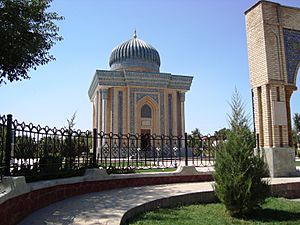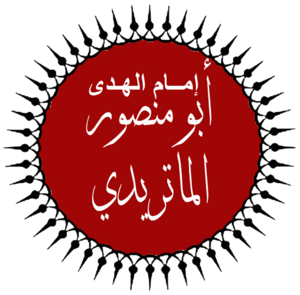Abu Mansur al-Maturidi facts for kids
Quick facts for kids Abū Manṣūr al-Māturīdī |
|
|---|---|

Tomb-shrine of Imam al-Māturīdī, Samarkand
|
|
| Scholastic theologian, Jurist; Leader of Guidance (Imām al-Hudā) Shaykh al-Islām Diver into the Sea of Knowledge Aʿraf al-nās bi-madhāhib Abī Ḥanīfa |
|
| Venerated in | Sunnī Islam |
| Major shrine | Tomb of Imam al-Māturīdī, Samarkand |
| Major works | Kitab al-Tawhid Ta'wilat Ahl al-Sunnah |
| Abū Manṣūr al-Māturīdī | |
|---|---|
 |
|
| Religion | Islam |
| Personal | |
| Born | 853 (238 H) Samarkand |
| Died | 944 (aged 90–91) (333 H) Samarkand, Samanid Empire |
| Influenced | the entire Māturīdī school |
Abū Manṣūr Muḥammad b. Muḥammad b. Maḥmūd al-Ḥanafī al-Māturīdī al-Samarḳandī (853–944 CE) was an important Muslim scholar. He is often called Abū Manṣūr al-Māturīdī or Imām al-Māturīdī by Sunni Muslims. He was an expert in Islamic law (called Fiqh), a writer who explained the Quran (called Tafsir), and a reformer. He also founded a major school of Islamic thought called the Māturīdī school.
This school became very important in Central Asia. Later, it was the main theological school for the powerful Ottoman Empire and the Mughal Empire. He was from a place called Māturīd in Samarkand (which is in modern-day Uzbekistan). During his life, people called him Shaykh al-Islām and Imām al-Hudā, meaning "Leader of Right Guidance."
He was one of the two most important leaders of Islamic theology in his time. The other was Abū al-Ḥasan al-Ashʿarī. While al-Ashʿarī followed the Shāfiʿī school of law, al-Māturīdī followed the Ḥanafī school. This school was founded by Abū Ḥanīfa al-Nuʿmān. Al-Māturīdī organized and explained the beliefs of the Ḥanafī school. He used these ideas to argue against other groups with different beliefs. These included groups like the Muʿtazilites and even non-Islamic religions.
Contents
Who Was Abū Manṣūr al-Māturīdī?
Abū Manṣūr al-Māturīdī's name comes from Māturīd or Māturīt. This was a place in Samarkand, which is now part of Uzbekistan.
His Teachers and Learning
Al-Māturīdī learned from many important teachers. Some of his main teachers included Muhammad bin Muqatil al-Razi and Abu Nasr al-Ayadi. He also learned from Nusayr bin Yahya al-Balkhi and Abu Bakr al-Juzjani.
He studied the teachings of Abu Hanifa, a very famous Islamic scholar. Al-Māturīdī's learning was connected through a chain of teachers back to Abu Hanifa himself. This showed how strong his connection was to the original teachings.
His Students and Influence
Al-Māturīdī also had many students who carried on his teachings. Some of his well-known students were Ali bin Said Abu al-Hasan al-Rustughfani and Abu Muhammad Abdal-Karim bin Musa bin Isa al-Bazdawi. Another important student was Abu al-Qasim al-Hakim al-Samarqandi. These students helped spread his ideas and build the Māturīdī school of thought.
His Life as a Scholar
Al-Māturīdī was born in Maturid, a village near Samarkand. We don't know a lot of small details about his daily life. Most of what we know comes from lists of his writings and short praises about him. It seems he lived as a dedicated scholar. He didn't hold public office or seek fame.
He had two main teachers who helped shape his religious ideas. People believed he lived a simple, spiritual life. Some even said he performed miracles. While he wasn't mainly a mystic, he might have known Sufis in his area. This is because religious law and mystical ideas were often connected there.
His Beliefs and Theology
Al-Māturīdī had clear ideas about faith (called īmān). He believed faith was about believing in your heart and saying it out loud. For him, good deeds were important, but they were not part of faith itself. He also thought that faith doesn't grow or shrink in its core. However, it can feel stronger through practice and repetition.
He believed in using allegorical interpretation for parts of the Quran that describe God in human-like ways. But he didn't agree with all the interpretations made by the Mu'tazilites. In other cases, he preferred to accept the revealed text without asking "how" (called bilā kayf).
Al-Māturīdī strongly defended the idea that God's qualities (like knowing everything or being powerful) are real and eternal. He also believed that humans could see God in the afterlife, but not fully understand Him with their eyes.
It's important to know that Al-Māturīdī was not a student of Al-Ash'ari. He had his own way of explaining Sunni Islam. He developed the ideas of Abu Hanifa and his followers.
His Important Works
During Al-Māturīdī's time, there were many different Islamic groups. He, along with two other scholars, wrote important books about Islamic beliefs. These other scholars were Abu al-Hasan al-Ash'ari in Iraq and Ahmad ibn Muhammad al-Tahawi in Egypt.
Al-Māturīdī and Al-Ash'ari were both Sunni Muslims. However, they had slightly different ideas. Al-Māturīdī followed Abu Hanifa's ideas. He taught that God creates human actions, but humans still have their own ability and will to act. This was a key difference from some other views.
Later, with the rise of Turkic states like the Great Seljuq Empire and the Ottoman Empire, the Hanafi-Maturidi school spread widely. It became popular in places where the Hanafi school of law was common. This includes countries like Pakistan, Afghanistan, Central Asia, South Asia, the Balkan region, Russia, China, and Turkey.
Al-Māturīdī knew a lot about different ancient religions and beliefs. His book Kitab al-Tawhid is a valuable source for researchers today. It contains information about groups like the Manicheans and Brahmans.
His Legacy and Respect
For a long time, especially outside of Central Asia, Al-Māturīdī's name was not as well-known as Al-Ash'ari's. But over time, Maturidism became recognized as the second main orthodox Sunni theological school. People visited his tomb in Samarkand for many centuries. This shows how much he was respected. Scholars praised his wisdom and spiritual gifts. They said God gave him many blessings and helped him guide others.
Today, some groups like Salafism and Wahhabism criticize Al-Māturīdī's ideas. They don't like using rational thought in religious matters. However, most traditional Sunni Muslims see Maturidism and Ashʿarīsm as the two main orthodox schools. The differences between them are often seen as minor. As one scholar said, "There is not much [doctrinal] difference between the Ashʿarīs and Māturīdīs, hence both groups are now called People of the Sunna and the Community."
His Writings
- Kitab al-Tawhid (Book of Monotheism)
- Ta'wilat Ahl al-Sunnah or Ta'wilat al-Qur'an (Book of the Interpretations of the Quran)
- Kitāb Radd Awa'il al-Adilla, a book arguing against a Mu'tazili book
- Radd al-Tahdhib fi al-Jadal, another argument against a Mu'tazili book
- Kitāb Bayan Awham al-Mu'tazila (Book of Exposition of the Errors of Mu'tazila)
- Kitāb al-Maqalat
- Ma'akhidh al-Shara'i' in Usul al-Fiqh
- Al-Jadal fi Usul al-Fiqh
- Radd al-Usul al-Khamsa, an argument against the Five Principles of the Mu'tazila
- Radd al-Imama, an argument against the Shi'i idea of the Imam
- Al-Radd 'ala Usul al-Qaramita
- Radd Wa'id al-Fussaq, an argument against the Mu'tazili idea that all grave sinners will be in hell forever.
See also
 In Spanish: Abu Mansur al-Maturidi para niños
In Spanish: Abu Mansur al-Maturidi para niños
- Maturidi
- Abu Hanifa
- Abu al-Mu'in al-Nasafi
- Abu Bakr al-Samarqandi
- 2020 International Maturidi Conference
- Imam Maturidi International Scientific Research Center
- List of Ash'aris and Maturidis
- List of Muslim theologians

